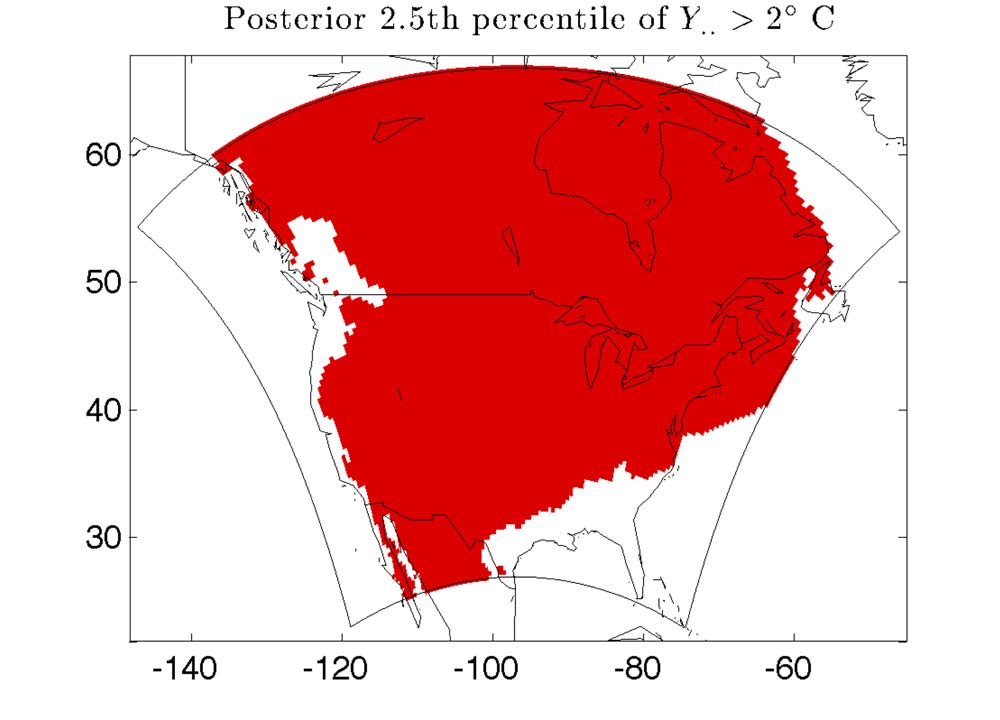Climate Models Brought to a Consensus Using a New Technique

While there is no question the world is heating up, predicting just how much it will warm and when is tricky. The answer can vary depending on which climate model you consult.
A new study has devised a way to build consensus. Using a new statistical method, scientists combined two climate models to look ahead as far as 2070 and get an idea of how much average temperatures would increase across North America.
"Some climate skeptics say, 'Oh, every climate model gives a different answer,' and this is true. The question is how different are the answers," said researcher Noel Cressie, a statistician at Ohio State University. He and former graduate student Emily Kang found that while the two models produced different results, the differences between the two were small when compared with the overall warming they predicted.
Different models
A climate model is made up of many equations that attempt to describe physical processes like the path of energy or water through oceans, atmosphere and land. Some of these processes are more easily represented than others. To get the more complex ones into a climate model, modelers must simplify these processes using a technique called parameterization. But not everyone does this exactly the same way. Likewise, modelers may also include varying levels of detail — say, including four versus 10 layers of soil when creating a model of land surface. The result: different models give somewhat different answers when asked about the future.
Models can simulate these dynamics on different geographic scales. Large ones can look at the entire globe, while regional models focus on a smaller scale.
A warming continent
Sign up for the Live Science daily newsletter now
Get the world’s most fascinating discoveries delivered straight to your inbox.
In this new study, Kang and Cressie used a new technique to bring two regional models to a consensus on the outcomes over North America.
To do so, the researchers first quantified the sources of variability in the raw numbers each model spit out using spatial statistics. From there, they inferred the consensus temperature change and the degree of certainty about the change, Cressie, the author of two books on spatial statistics, told LiveScience in an email.
They divided the continent into about 12,000 grid squares, each measuring 31 miles (50 kilometers) on a side. The net effect was a map made up of tiny pixels. And for each pixel, they performed these calculations, which allowed them to look at changes in both overall and seasonal warming.
To determine a change in temperature, the researchers started with the present — which they defined as the average for the period spanning 1971 to 2000 — along with the projected future temperatures, or the average temperatures for the 30-year period 2041 to 2070. [The Reality of Climate Change: 10 Myths Busted]
Large and small scale
With all grid squares taken into account, their work indicated that most of the continent — except for bits along the coasts, particularly in the Southeast and Pacific Northwest and much of Newfoundland — has at least a 97.5 percent probability of warming up by more than 3.6 degrees Fahrenheit (2 degrees Celsius) by 2070. This wasn't a surprise; the U.N.'s Intergovernmental Panel on Climate Change makes predictions on this scale for the globe.
This overall projection, however, glosses over a lot of interesting detail. To highlight the variety within their results, they pulled out the seasonal results for a few of the grid squares.
For example, for a point in the Hudson Bay, north of mainland Canada, the models pointed to relatively minor increases in summer and fall, but a dramatic 11-degree F (6-degree C) increase in winter. Their approach allows them to say there is a 95 percent probability that temperature increase will be in the range 10.6 to 11 degrees F (5.9 to 6.1 degrees C). [The World's Weirdest Weather]
Exploring uncertainty
This study is a small piece of a much larger project, North American Regional Climate Change Assessment Program (NARCCAP), which seeks to better understand how temperature change will play out on a relatively fine geographic scale and so provide better information for planning.
To do this, NARCCAP researchers, including Cressie and Kang, are using six regional models and four global ones.
The big question is: How will the climate respond to greenhouse gases and other human emissions? The variation in the projections made by different models is a part of that larger uncertainty, said Linda Mearns, a senior scientist at the National Center for Atmospheric Research and the director NARCCAP.
To a climate scientist like Mearns, the word "uncertainty" has a specific meaning.
"The uncertainty is about how big the change in temperature will be, for example, not whether or not there will be one," Mearns said.
The most significant aspect of Cressie and Kang's research is the statistical method they used to combine the two regional climate models, she said.
Their work is detailed in an article published online earlier this year in the International Journal of Applied Earth Observation and Geoinformation.
You can follow LiveScience senior writer Wynne Parry on Twitter @Wynne_Parry. Follow LiveScience for the latest in science news and discoveries on Twitter @livescience and on Facebook.











